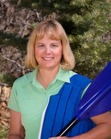Beth Groundwater's Blog, page 11
August 29, 2013
Today's Mystery Author Guest: Aaron Paul Lazar
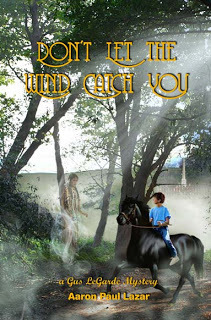
As promised yesterday, fellow mystery author Aaron Paul Lazar is visiting my blog today. To read his bio and see his photo, please page down to yesterday's post. Also, Aaron is running a contest for a free electronic copy of the latest book in his young adult Gus LeGarde series, Don't Let the Wind Catch You , the cover art for which appears above. Aaron will select the winner tomorrow evening from among those who leave a comment today or tomorrow and will announce the name in a comment on this post. He will give away a Kindle compatible copy and a Nook compatible copy, so be sure to specify which format you would like in your comment.
In the book, when young Gus LeGarde befriends a cranky old hermit in the woods who speaks to an Oneida Indian spirit named Penaki, he wonders if the man is nuts. But when Penni rattles tin cups, draws on dusty mirrors, and flips book pages, pestering them to find evidence to avenge her past and free her from earthly bondage, things change. What Gus doesn’t understand is why his mother hates Tully. His relentless digging reveals a hint of scandal about Tully and Gus’s maternal grandfather, Marlowe Wright. Can his natural compassion help him accept the not-so-normal facts about Tully and Marlowe?
On horseback, Gus and his friends ride through woods overlooking Conesus Lake, following Penni’s trail to an abandoned house reportedly infected with the deadly Genesee Valley Fever from the 1700s. Unafraid, they enter and make an astounding find that could rewrite history. Gus summons courage beyond his years in this poignant and powerful telling of the sultry summer of 1965.
Sounds like a very interesting read to me, even if you aren't a young adult! Below is Aaron's guest post.
An Indian Soul by Aaron Paul Lazar
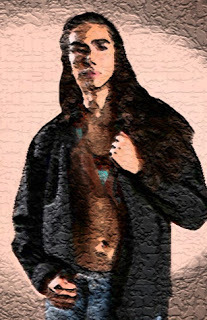
I’ve always been fascinated by Indian* culture. Not from a touristy point of view, mind you, but more from a strong, unyielding pull that comes from deep inside me and seems to grow stronger with every year.
I’m not sure why this is happening, but I do know I have some native blood flowing in my veins. My grandmother told me that one of her French Canadian ancestors married a native woman. I’ve been proud of that fact all my life, but went along blindly accepting the fact without asking more questions until it was too late. My grandmother and father both died in the same year—1997—and there’s no one else to query about which tribe my great, great, great grandmother may have belonged to, or where she lived in Canada. I do know that my grandmother was born in a little town named Beau Rivage, near Quebec, and that it no longer exists because of an intentional flooding done to create a lake, or some such thing. Some folks have suggested our tribe was the Metis, but I have no proof. I never asked my grandmother more than that. Sigh. I really wish I had.
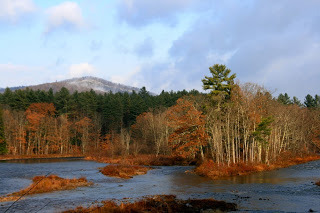
But there’s something inside that draws me to the woods and outdoors with such a visceral pull, I can’t resist. I’m deeply happy when I’m hiking in the woods, tending my gardens, or sitting beside the Sacandaga River. I frequently imagine what life would have been like as an Indian brave—hunting, tending orchards, managing crops, running through the woods all day. It’s more than an occasional speculative thought. I seem to think about it a lot.
I believe God intended us to live as one with nature, managing our woods and fields carefully, without chemicals. This concept starkly contrasts with the lives many of us have now, sitting in an office behind a computer screen. Our bodies aren’t meant to do that, they’re meant to move and bend, with the strength and agility that comes from activity. If only we could somehow recapture the beautiful, natural ways of our ancestors who lived and nurtured the land, I know we’d eliminate high blood pressure, cancer, diabetes, and more.
When I started to write my Don’t Let the Wind Catch You, the sequel to Tremolo: cry of the loon, I decided to make the ethereal spirit who shows up in chapter 1 an Oneida Indian.
The Iroquois Nation, whose people call themselves the Hau de no sau nee, consists of six individual tribes located in the northeastern region of North America. The Six Nations includes the Mohawk, Oneida, Onondaga, Cayuga, Seneca, and Tuscarora. I chose the Iroquois tribes because I know people of this tribe once lived and walked on the same trails I frequent, and it seemed fitting, you know?
Penaki, or Penni, as she’s affectionately known, pesters young Gus and his friends to find evidence in an old abandoned house that is rumored to still harbor the virus for the Genesee Valley Fever, which killed hundreds in the late 1700s. She needs to be avenged by having the truth come out, so she can be released from her earthly bonds.
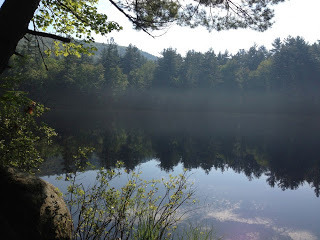
When I write about Native Americans, whether it’s Don’t Let the Wind Catch You or my new Tall Pines series, I feel most inspired while sitting by the Sacandaga River in Hope, New York, or hiking the deep woods nearby. I picture the land before roads bisected its wild beauty, before electric poles marred its view, in a time when man had to rely on his skill and wit to survive.
Like I said, I’ve always been fascinated by this culture. In lieu of going back in time to live life among the trees and rivers, I guess I’m creating a new world, where treachery may lurk around each corner, but where natural beauty abounds, as well.
I’m definitely enjoying the ride.
You can read the first chapters in Don’t Let the Wind Catch You by clicking on the title. Let me know what you think by contacting me at aaron.lazar AT yahoo.com.
*I’ve read a lot of books on Indians lately, and have been educated to discover that most tribes don’t like being called Native American. They prefer either their tribe name (like Seneca or Cherokee), or native people, or Indian. So I’m trying to dump the PA term from most of my discussions to honor them.
Thanks Aaron! Now, who has a comment or question for Aaron Paul Lazar? Good luck in the contest!
Published on August 29, 2013 03:00
August 28, 2013
Tomorrow's Guest: Aaron Paul Lazar
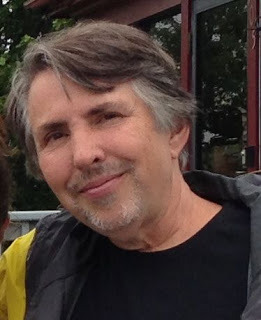
Tomorrow, fellow mystery author Aaron Paul Lazar will guest on my blog. He will talk about his Indian soul, and I'm sure you'll be intrigued by what he has to say. Also, Aaron will run a contest for an electronic copy of Don't Let the Wind Catch You, the latest book in his young adult Gus LeGarde series. He will choose the winner from among those who leave a comment. He will give away a Kindle compatible copy and a Nook compatible copy, so be sure to specify which format you would like in your comment.
Aaron Paul Lazar writes to soothe his soul. An award-winning, bestselling Kindle author of three addictive mystery series, Aaron enjoys the Genesee Valley countryside in upstate New York, where his characters embrace life, play with their dogs and grandkids, grow sumptuous gardens, and chase bad guys. Watch for his upcoming releases, The Seacrest (2013), Sanctuary (2014), and Virtuoso (2014).
Published on August 28, 2013 03:00
August 26, 2013
Danger in a Remote River Canyon
I'm at Inkspot, the blog for Midnight Ink authors, today, with a report on my research trip down Cataract Canyon on the Colorado River in Utah that I took for
Fatal Descent
, the third book in my RM Outdoor Adventures series. Head on over there to see some spectacular scenery shots!
Published on August 26, 2013 06:54
August 23, 2013
A Bicycle Tour in the Lot Valley of France - Part 3
This is the third part of my report on my May trip to the Lot Valley in France. For the first two parts, page down below this report.
On the fifth day of our stay at the Domaine du Haut Baran, we took the day off from bicycling to tour the religious site of Rocamadour (Wikipedia article) with William as our very well-informed guide. It features a basilica complex built into a cliffside and was the fourth most visited Christian pilgrimage site after the Holy Lands, the Vatican, and St Jacques de Compostelle in Spain.
On the way we toured a still-operating flour mill built in the thirteenth century by four generations of monks (see photos below). In the last photo, Neil and I are sitting in the kitchen fireplace used by the monks and that is still being used, on that day to cook a duck for dinner for the mill guide and his wife.
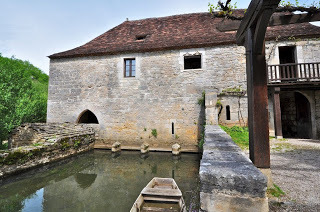
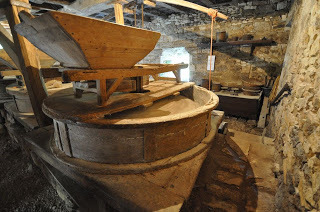
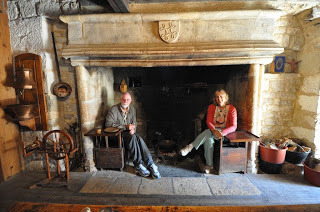
We started our visit to Rocamadour by lunching at a restaurant across the valley that gave us a spectacular view of the site.
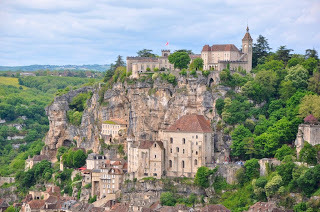
Then we started our tour in the village at the base of the cliff (first photo below), and climbed the stairs (second photo) to the basilica level (third photo).
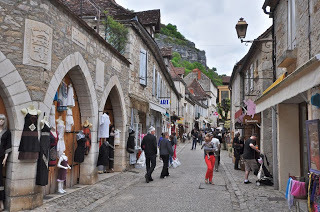
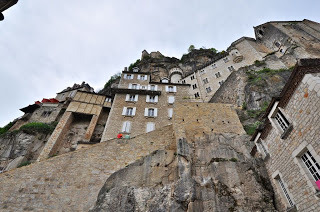
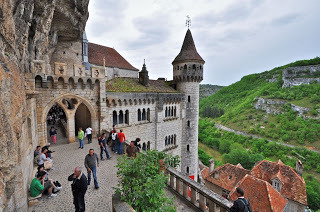
The first photo below shows the best-preserved of the religious murals that originally graced all the walls of the complex. We saw many religious icons that were the source of purported miracles, including the sword in the stone (second photo, chained to prevent theft), the black madonna statue (third photo), and the bell with a stationary clapper that only rang when a miracle was to occur (fourth photo).
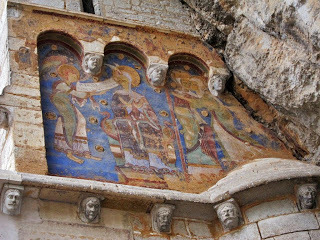

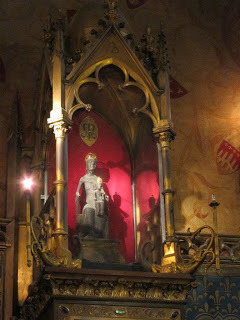
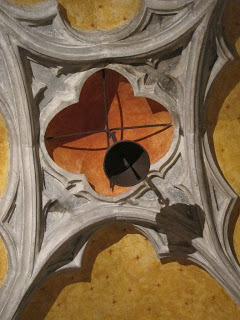
Then we climbed up the rest of the hillside along a trail that passed by the stations of the cross (first photo below). Dinner that night was at a local restaurant run by a couple from New Zealand (second photo).

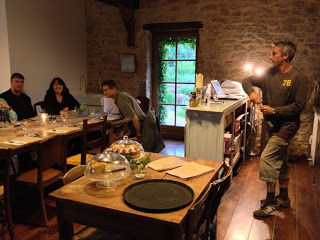
Our sixth day was our longest day of cycling, 36 miles. We started with a displacement via our support van (first photo below) to Assier. We cycled the rolling farmland (complete with cows and sheep, second and third photos) then rode downhill to the Cele River and followed the route of the pilgrims of St Jacques de Compostelle. We stopped at the church Espagnac-St Eulalie from the 12th century.
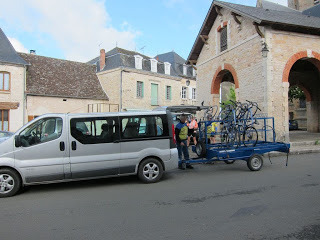
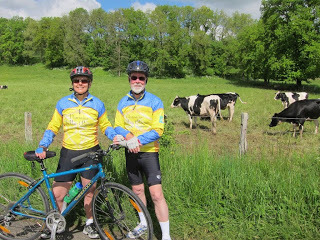
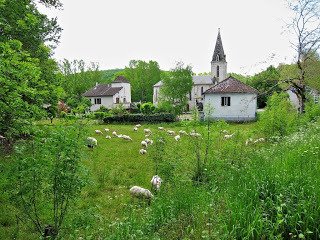
Then Rosalie (in the blue jacket below) outdid herself by laying out a gourmet picnic lunch spread at the roadside tables just past St Sulpice.
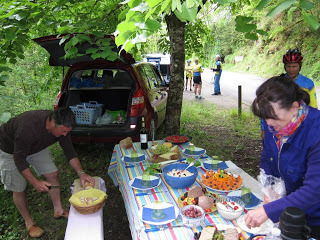
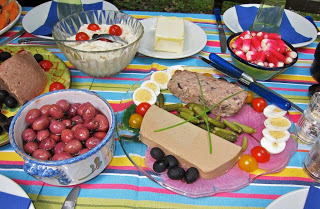
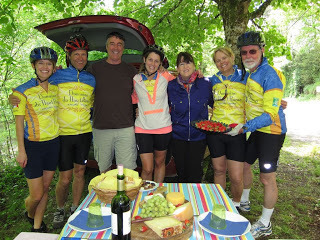
With very full tummies, we continued past the Troglodyte homes and the Musée du Insolite and finished our ride in the town of Cabarets. We toured the Grotte de Pech Merle caves there with their prehistoric paintings of hunting scenes including woolly mammoths, then returned to Haut Baran via Cahors and a short photo op at the Pont Valentré (Devil's Bridge--second photo below). We celebrated our week with a scrumptious dinner of pork loin stuffed with prunes. The next day we were driven back to the Toulous airport by Paul, vowing to return soon!
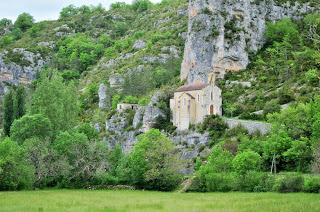
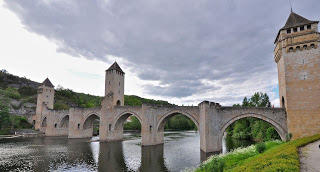
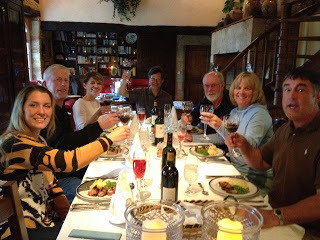
On the fifth day of our stay at the Domaine du Haut Baran, we took the day off from bicycling to tour the religious site of Rocamadour (Wikipedia article) with William as our very well-informed guide. It features a basilica complex built into a cliffside and was the fourth most visited Christian pilgrimage site after the Holy Lands, the Vatican, and St Jacques de Compostelle in Spain.
On the way we toured a still-operating flour mill built in the thirteenth century by four generations of monks (see photos below). In the last photo, Neil and I are sitting in the kitchen fireplace used by the monks and that is still being used, on that day to cook a duck for dinner for the mill guide and his wife.



We started our visit to Rocamadour by lunching at a restaurant across the valley that gave us a spectacular view of the site.

Then we started our tour in the village at the base of the cliff (first photo below), and climbed the stairs (second photo) to the basilica level (third photo).



The first photo below shows the best-preserved of the religious murals that originally graced all the walls of the complex. We saw many religious icons that were the source of purported miracles, including the sword in the stone (second photo, chained to prevent theft), the black madonna statue (third photo), and the bell with a stationary clapper that only rang when a miracle was to occur (fourth photo).




Then we climbed up the rest of the hillside along a trail that passed by the stations of the cross (first photo below). Dinner that night was at a local restaurant run by a couple from New Zealand (second photo).


Our sixth day was our longest day of cycling, 36 miles. We started with a displacement via our support van (first photo below) to Assier. We cycled the rolling farmland (complete with cows and sheep, second and third photos) then rode downhill to the Cele River and followed the route of the pilgrims of St Jacques de Compostelle. We stopped at the church Espagnac-St Eulalie from the 12th century.



Then Rosalie (in the blue jacket below) outdid herself by laying out a gourmet picnic lunch spread at the roadside tables just past St Sulpice.



With very full tummies, we continued past the Troglodyte homes and the Musée du Insolite and finished our ride in the town of Cabarets. We toured the Grotte de Pech Merle caves there with their prehistoric paintings of hunting scenes including woolly mammoths, then returned to Haut Baran via Cahors and a short photo op at the Pont Valentré (Devil's Bridge--second photo below). We celebrated our week with a scrumptious dinner of pork loin stuffed with prunes. The next day we were driven back to the Toulous airport by Paul, vowing to return soon!



Published on August 23, 2013 03:30
August 21, 2013
A Bicycle Tour in the Lot Valley of France - Part 2
This is the second part of my report on my May trip to the Lot Valley in France. For the first part, page down below this report.
During our third day at Domaine Du Haut Baran, we biked from the Haut Baran south to cross the Lot River in Vire-Sur-Lot and then turned right onto the D5 to ride to Lacapelle-Cabanac. We climbed 500 feet in altitude to the Lacapelle overlook then rode downhill to the Lot River again and crossed via the suspension bridge in Touzac. We followed farm roads along the river to Condat and a small mill stream in town where we saw a beautiful swan in the river.
Then we cycled to the Bonaguil Chateau, (Wikipedia article) the last of the fortified castles built in France in the 13th century. This ride was 18 miles long, and we arrived at the Chateau in time to have lunch with Belgian beer at a restaurant outside before William, a French history buff, gave us an excellent tour of the grounds that lasted the rest of the afternoon.
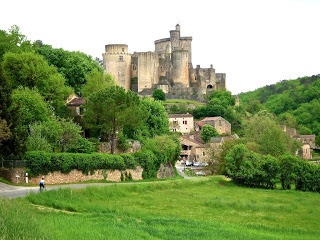
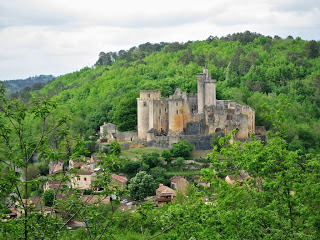
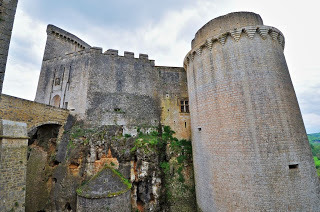
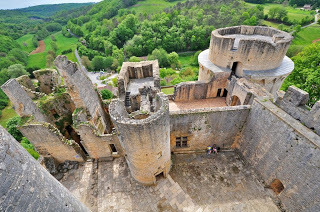
That evening we dined at Henry's restaurant in Puy L’Eveque and had an excellent meal.
On the fourth day, we rode in the support van to Mercuès then cycled to the nearby Chateau Lagrezette winery for a morning tasting. The winery tasting room and one of its vineyards are shown in the first two photos below. The next two show some of the beautiful wisteria that was in bloom everywhere we rode.
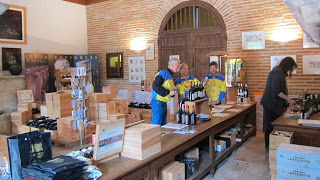
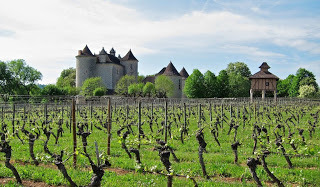
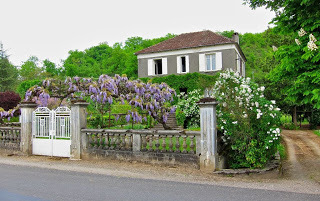
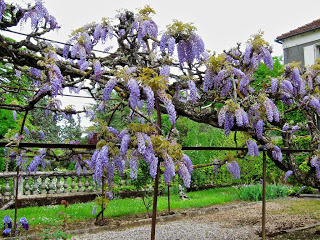
After the winery we rode to the farmers' market in Luzech (see photos below) to select and buy goodies for lunch, including cheeses, meats, breads, fruit, and paella. I also bought some pâte and foie gras to take home.
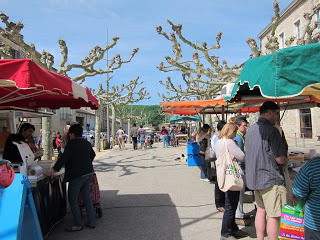
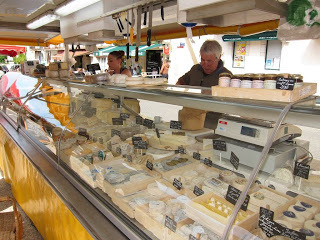
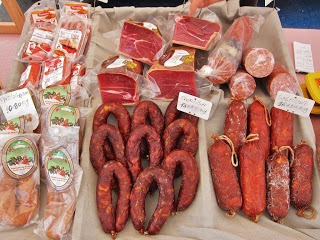
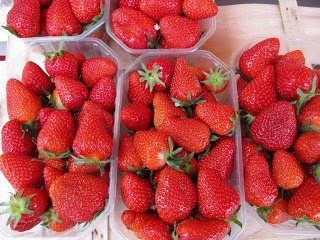
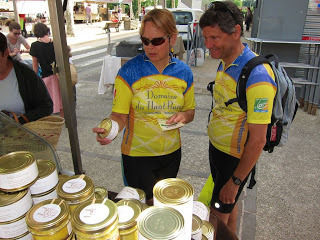
Then we crossed the Lot River in Castelfranc and rode to Grezel to picnic beside the mill stream. William is in the white shirt cutting cantalope in the last photo.
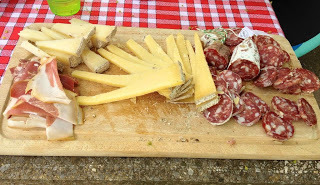
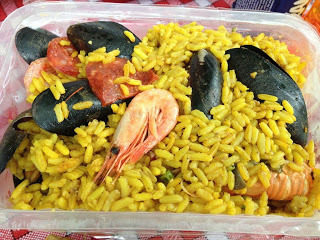
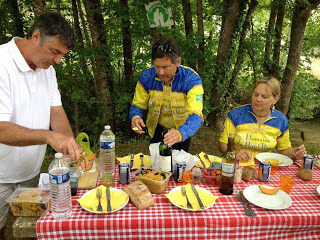
After a wine-soaked lunch, we rode to the river’s edge in Puy L’Eveque and then along the LaGrezette vineyards to Vire-sur-Lot. We stopped to tour the church in Vire (first two photos below) before a ride in the van back to the Haut Baran. The chef-prepared dinner that evening featured Confit du Canard (last photo).

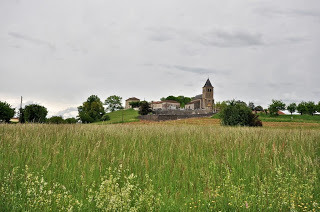
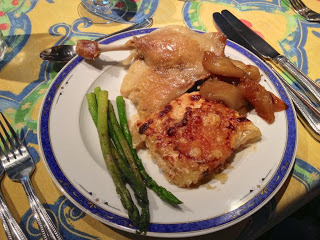
During our third day at Domaine Du Haut Baran, we biked from the Haut Baran south to cross the Lot River in Vire-Sur-Lot and then turned right onto the D5 to ride to Lacapelle-Cabanac. We climbed 500 feet in altitude to the Lacapelle overlook then rode downhill to the Lot River again and crossed via the suspension bridge in Touzac. We followed farm roads along the river to Condat and a small mill stream in town where we saw a beautiful swan in the river.
Then we cycled to the Bonaguil Chateau, (Wikipedia article) the last of the fortified castles built in France in the 13th century. This ride was 18 miles long, and we arrived at the Chateau in time to have lunch with Belgian beer at a restaurant outside before William, a French history buff, gave us an excellent tour of the grounds that lasted the rest of the afternoon.




That evening we dined at Henry's restaurant in Puy L’Eveque and had an excellent meal.
On the fourth day, we rode in the support van to Mercuès then cycled to the nearby Chateau Lagrezette winery for a morning tasting. The winery tasting room and one of its vineyards are shown in the first two photos below. The next two show some of the beautiful wisteria that was in bloom everywhere we rode.




After the winery we rode to the farmers' market in Luzech (see photos below) to select and buy goodies for lunch, including cheeses, meats, breads, fruit, and paella. I also bought some pâte and foie gras to take home.





Then we crossed the Lot River in Castelfranc and rode to Grezel to picnic beside the mill stream. William is in the white shirt cutting cantalope in the last photo.



After a wine-soaked lunch, we rode to the river’s edge in Puy L’Eveque and then along the LaGrezette vineyards to Vire-sur-Lot. We stopped to tour the church in Vire (first two photos below) before a ride in the van back to the Haut Baran. The chef-prepared dinner that evening featured Confit du Canard (last photo).



Published on August 21, 2013 03:30
August 19, 2013
A Bicycle Tour in the Lot Valley of France - Part 1
I've been so busy with mystery author guests, news about my own books, and reporting on my summer activities in Summit County here on my blog that I haven't had a chance to share photos from my wonderful May bicycling tour in the Lot Valley of France. There's no guest this week, so here goes!
My husband and I flew into Toulouse, France, and we spent a couple of nights there so we could spend a day touring the city before the bike tour. The next day we were picked up by Paul, our van support person, at our hotel and driven about two hours to where we would stay in the Lot Valley, at the Domaine Du Haut Baran. It is the most gorgeous B and B/guest lodge/small inn we have ever stayed in by far! The grounds are lush and beautifully landscaped, as shown in the two photos below.
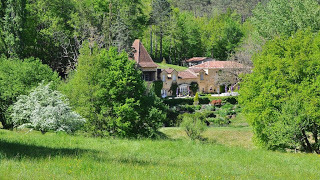
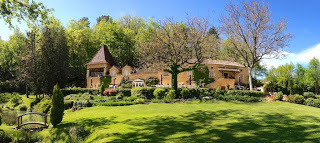
Our room was very comfortable (see first photo below) and stocked full of extras like thick robes for wearing to and from the outdoor pool and whirlpool. Along with bike tours like ours, William and Rosalie, the owners of the Haut Baran, host horseback riding, hiking, wine tasting, and cooking tours and artists workshops, among other activities. The second photo below shows the view out of our balcony. Sigh!
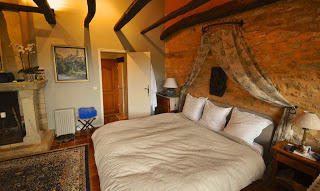
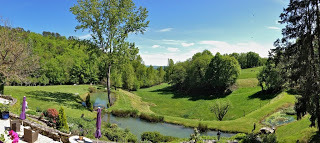
After trying on our Haut Baran bike jerseys and jackets for size, we walked around the neighborhood the first afternoon and spotted the gypsy cavern collection in one neighbor's yard and the menagerie of table animals (chickens, ducks, geese, rabbits) in another's. Then after aperitifs and appetizers on the patio, we were treated to a gourmet dinner prepared by a local chef (who cooks dinners for groups the nights they eat in) with wines selected by William to match. Then, cognac in the drawing room and a short stumble back to our room. The first photo below shows me at the dining table the next morning for breakfast (with Paul) and part of the attached living room.
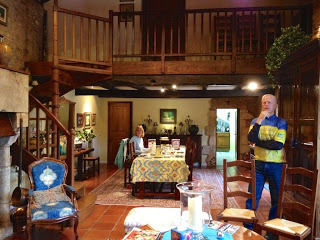
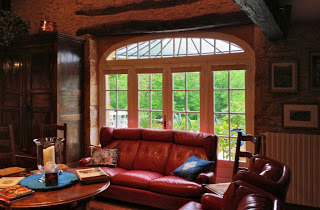
On our second day at the Haut Baran, our first full day of biking, we rode south from the inn, crossed the Lot River at Vire-sur-Lot then rode on a country lane through vineyards to the town of Puy L’Eveque, shown behind us in the photo below. I'm sandwiched between our biking guide, Joe, and my husband, Neil.
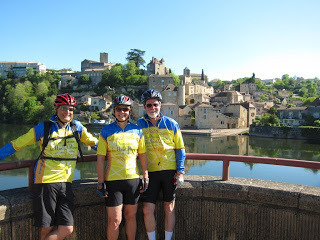
After a rest stop in Grezel, we biked up a small hill into Albas for photos at the overlook, where Neil really got into the wine tasting spirit!
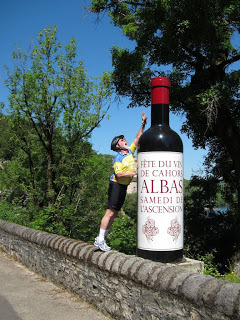
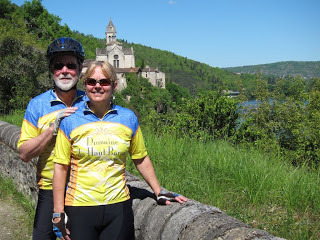
Then we crossed the Lot River again below Albas (I'm on the bridge in the photo below) and stopped for lunch in Castelfranc, a 13th century Bastide town. After lunch, we cycled to the Trigudina winery for a tasting of Cahors (Malbec) wine, a sparkling Rosé and a local white (50-50 Viognier/Chardonnay). The winery is shown in the last two photos below. Since we were a little tipsy by then and close to the Haut Baran, we opted to ride in the van back. Total distance: 32 miles.
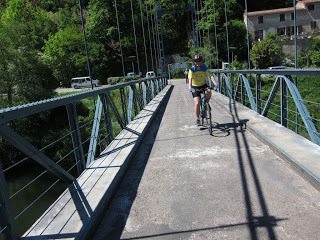
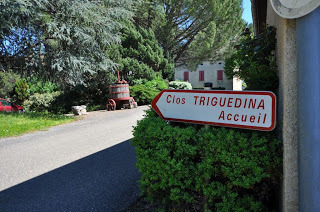
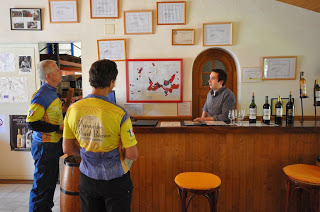
My husband and I flew into Toulouse, France, and we spent a couple of nights there so we could spend a day touring the city before the bike tour. The next day we were picked up by Paul, our van support person, at our hotel and driven about two hours to where we would stay in the Lot Valley, at the Domaine Du Haut Baran. It is the most gorgeous B and B/guest lodge/small inn we have ever stayed in by far! The grounds are lush and beautifully landscaped, as shown in the two photos below.


Our room was very comfortable (see first photo below) and stocked full of extras like thick robes for wearing to and from the outdoor pool and whirlpool. Along with bike tours like ours, William and Rosalie, the owners of the Haut Baran, host horseback riding, hiking, wine tasting, and cooking tours and artists workshops, among other activities. The second photo below shows the view out of our balcony. Sigh!


After trying on our Haut Baran bike jerseys and jackets for size, we walked around the neighborhood the first afternoon and spotted the gypsy cavern collection in one neighbor's yard and the menagerie of table animals (chickens, ducks, geese, rabbits) in another's. Then after aperitifs and appetizers on the patio, we were treated to a gourmet dinner prepared by a local chef (who cooks dinners for groups the nights they eat in) with wines selected by William to match. Then, cognac in the drawing room and a short stumble back to our room. The first photo below shows me at the dining table the next morning for breakfast (with Paul) and part of the attached living room.


On our second day at the Haut Baran, our first full day of biking, we rode south from the inn, crossed the Lot River at Vire-sur-Lot then rode on a country lane through vineyards to the town of Puy L’Eveque, shown behind us in the photo below. I'm sandwiched between our biking guide, Joe, and my husband, Neil.

After a rest stop in Grezel, we biked up a small hill into Albas for photos at the overlook, where Neil really got into the wine tasting spirit!


Then we crossed the Lot River again below Albas (I'm on the bridge in the photo below) and stopped for lunch in Castelfranc, a 13th century Bastide town. After lunch, we cycled to the Trigudina winery for a tasting of Cahors (Malbec) wine, a sparkling Rosé and a local white (50-50 Viognier/Chardonnay). The winery is shown in the last two photos below. Since we were a little tipsy by then and close to the Haut Baran, we opted to ride in the van back. Total distance: 32 miles.



Published on August 19, 2013 03:30
August 16, 2013
Wildflower Hike on Shrine Mountain Trail
Last week my "Women With Altitude" hiking group tackled the Shrine Mountain Trail. The trailhead is off of Shrine Mountain Road, about 2.3 miles past where it peels off the Vail Pass Rest Area parking lot in Colorado. We'd been told by friends that the wildflowers were particularly beautiful on this trail, and they were soooooo right! The photos below don't do them justice. The first photo is of most of the group (minus the photographers), and the next three are of wildflowers.
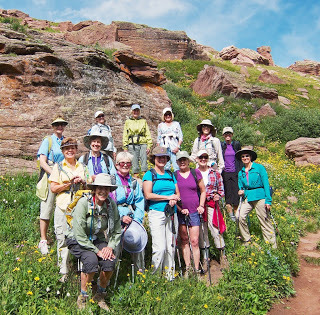
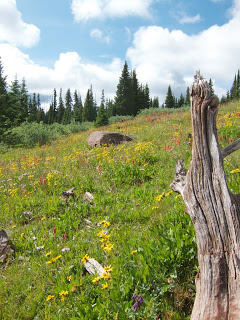
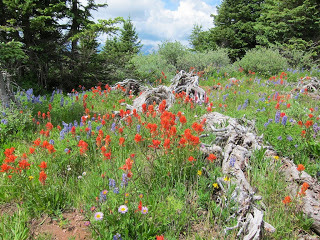
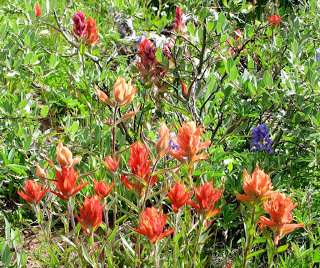
Then there are the views! Once you reach the top of the ridge, you can see Mt. Holy Cross off to the southwest, the Gore Range to the north and the Tenmile Range to the east. Also, there's the "shrine" itself, a bulwark of a red rock formation (as seen in the first photo below) across a small hanging valley from the ridge the trail goes on (in the second photo).
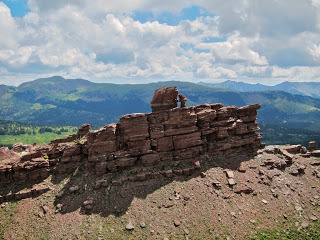
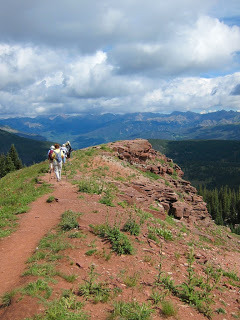
And there were beautiful but deadly mushrooms. All in all, a fine day for a hike with fine company!
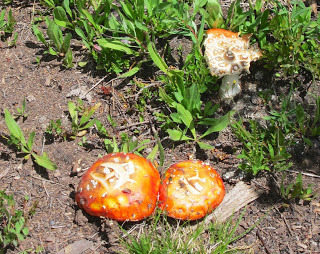




Then there are the views! Once you reach the top of the ridge, you can see Mt. Holy Cross off to the southwest, the Gore Range to the north and the Tenmile Range to the east. Also, there's the "shrine" itself, a bulwark of a red rock formation (as seen in the first photo below) across a small hanging valley from the ridge the trail goes on (in the second photo).


And there were beautiful but deadly mushrooms. All in all, a fine day for a hike with fine company!

Published on August 16, 2013 03:30
August 14, 2013
Today's Mystery Author Guest: Beate Boeker
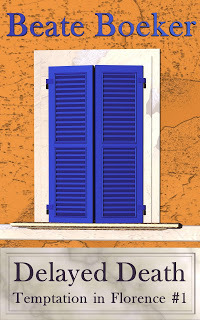
As promised yesterday, fellow mystery/thriller author Beate Boeker is visiting my blog today. To read her bio and see her photo, please page down to yesterday's post. Also, Beate is running a contest for a free electronic copy of the first book in her Temptation in Florence series, Delayed Death , the cover art for which appears above. Beate will select the winner tomorrow evening from among those who leave a comment today or tomorrow and will announce the name in a comment on this post.
The book asks the question, "What do you do when you find your grandfather dead half an hour before your cousin's wedding?" The answer is that you hide him in his bed and tell everyone he didn't feel like coming. Delayed Death is an entertaining mystery set in Florence, Italy. When Carlina finds her grandfather dead on the day of her cousin's wedding, she decides to hide the corpse until after the ceremony. However, her grandfather was poisoned, and she becomes the attractive Inspector's prime suspect. On top of that, she has to manage her boisterous family and her luxurious lingerie store called Temptation, a juggling act that creates many hilarious situations.
Sounds like a "tempting" read! ;-) Below are Beate's answers to my interview questions.
1. Who or what inspired you to start writing and when did you start?
My first novel was written when I was a teenager, and as soon as it was done, I thought it was hugely embarrassing. I picked writing up again in my thirties and then, I quickly realized that I would not get the necessary help to learn the tools of the trade in Germany as I found no online writing communities like the ones in the US. So I started to write in English in spite of the fact that I'm German and have been living in Germany most of my life. My first romance novel was published by Avalon Books in 2008.
2. What tools and process do you use to “get to know” your characters before and while you’re writing the books?
None. I just start to write, and then they unfold. From time to time, they behave in a very erratic way, and I have to change my original ideas in order to make them fit. Recently, for example, the rather eccentric mother of my heroine declared during a family meeting that she would create a “trap for the murderer”. I was aghast. That trap had not been planned, but once she had said it, I realized I had to create one. It took me several hours to come up with one that would fit into my plot.
3. How do you construct your plots? Do you outline or do you write “by the seat of your pants”?
It depends. I outline the mysteries because it wouldn't do to write one without knowing who's the murderer, but with my romances, I usually just have a hook at the beginning, and then I let it take over.
4. In the age-old question of character versus plot, which one do you think is most important in a murder mystery and which one do you emphasize in your writing? Why?
Obviously, it's best if both go together, but for me, the emphasis is on characters. I don't need a cliff hanger and life-and-death questions at every corner. I prefer to be taken on a trip, to see things from a different perspective, to play with viewpoints and insights and feelings.
5. What is the biggest challenge you’ve faced as a writer and what inspires you and keeps you motivated?
The biggest challenge is the marketing, though I'm a marketing professional in my day job, so it shouldn't daunt me. However, it feels more like a chore than an passion when it comes to promoting myself. The writing itself inspires me and makes me happy. It's part of what I have to do to keep my soul alive. Also, I love to read my stories out loud and hear people laugh at the places that I find funny. Hard to top that!
6. What is a typical workday for you and how many hours a day (or week) do you devote to writing?
I guess I write like six hours a week, only on the weekends. During the week, I do marketing stuff because I can only do it in the evenings, after both the day job and the family are dealt with. My best writing time is in the mornings, right after breakfast. Or after an afternoon nap! I need roughly nine months to write one full-length novel.
7. What advice do you have to offer to an aspiring author?
I've got two bits of advice, actually! First, listen to the things that are shared in author loops, i.e. learn the trade. Second: Never give up.
8. Now here’s a zinger. Tell us something about yourself that you have not revealed in another interview yet. Something as simple as your favorite TV show or food will do.
My curls are natural. They took ages to come; in fact, I could already walk and didn't have any hair, and my mother was getting worried that this would have to be my permanent look. She was very relieved when they finally spiraled their way into freedom. :-)
9. What are you working on now and what are your future writing plans?
I'm editing the third novel in the series Temptation in Florence. It's called Banker's Death, and the stakes are high when the family realizes that they're in danger of losing their home. After that, I plan to translate my most popular romance, A New Life, into German. It's also set in Italy, and it's about a young woman who has to start from scratch in a new town and with a language she hardly knows. I've just started to translate my own novels and find it surprisingly difficult. It shouldn't be, as it's my mother tongue, but I keep having to look up expressions in the dictionary.
10. Is there anything else you would like to tell my blog readers?
I love cozy and funny mysteries like Murder with Peacocks by Donna Andrews. If they include a bit of romance, even better! If you have any recommendations for me, do tell me about it, so I can hunt them up and read them!
Also, you can find me on Facebook HERE and on Twitter HERE, as well as on my website.
Thanks, Beate! Now, who has a comment or question for Beate Boeker? Good luck in the contest!
Published on August 14, 2013 03:30
August 13, 2013
Tomorrow's Guest: Beate Boeker
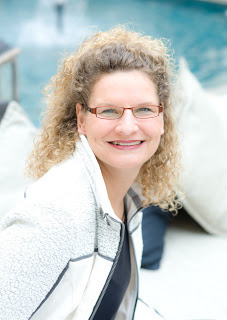
Tomorrow, fellow mystery author Beate Boeker will guest on my blog. She answers my interview questions, and I'm sure you'll be intrigued by what she has to say. Also, Beate will run a contest for an electronic copy of Delayed Death , the first book in her Temptation in Florence series. She will choose the winner from among those who leave a comment.
Beate Boeker has been a traditionally published author since 2008 and now offers many full-length novels and short stories online. Several were shortlisted for the Golden Quill Contest, the National Readers' Choice Award, and the 'Best Indie Books of 2012' contest. She is a marketing manager by day with a degree in International Business Administration, and her daily experience in marketing continuously provides her with a wide range of fodder for her novels, be it hilarious or cynical. While 'Boeker' means 'books' in a German dialect, her first name Beate can be translated as ‘Happy’ . . . and with a name that reads ‘Happy Books’, what else could she do but write novels with a happy end?
Published on August 13, 2013 03:30
August 7, 2013
Today's Mystery/Thriller Author Guest: L. A. Starks
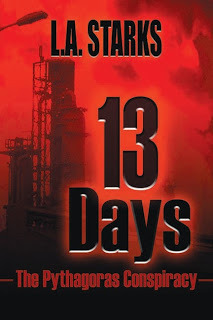
As promised yesterday, fellow mystery/thriller author L. A. Starks is visiting my blog today. To read her bio and see her photo, please page down to yesterday's post. Also, L. A. is running a contest for a free autographed copy of the first book in her Lynn Dayton series, 13 Days: The Pythagoras Conspiracy , the cover art for which appears above. L. A. will select the winner tomorrow evening from among those who leave a comment today or tomorrow and will announce the name in a comment on this post.
In the book, energy executive Lynn Dayton thinks her challenge is fixing the troubled Houston refinery her company just bought. But she discovers she must save it, and hundreds of people in nearby Ship Channel plants, from havoc and deaths directed by a French saboteur. Simultaneously, she fights off threats to her own life. As Lynn deals with chemical leaks, disloyal employees, a new season of hurricanes, and mounting casualties, corrupted idealist Robert Guillard plans to manipulate her through her vulnerable sister. But Robert underestimates his prey.
Sounds like an exciting read! Below are L. A.'s answers to my interview questions.
1. Who or what inspired you to start writing and when did you start?
Reading inspired me to start writing. Until I graduated from college I weighed the possibility of creative or free-lance writing. However, with the need to make a living, I decided on finance and engineering. Those sound like opposites of fiction writing but they have in common with it the discipline of precision. And, engineering is a traditional career for both women and men in the Southwest, where I grew up.
Later I started writing non-fiction articles on energy and investing. About ten years ago, I was finally ready to write a full-length fiction manuscript. When I got to 60,000 words, I thought, “I’ve almost written a book.” Au contraire. How little I knew.
2. What tools and processes do you use to get to know your characters before and while you’re writing the books?
I research names and cultural identities. For key characters, I construct biographies—life events and motivations that make them who they are. I tend to write in a lot of characters, so describing them memorably in just a few words is a constant challenge.
3. How do you construct your plots? Do you outline or write “by the seat of your pants?”
I wrote my first book the same way movies are shot—scenes out of sequence—as they occurred to me. While this helped me finish, I had a huge editing job to remove tangents and make the plot cohesive. For the second book, I outlined. Of course characters don’t always behave the way one plans. I am outlining the third book but it’s unlikely the finished book will exactly follow the initial outline.
4. In the age-old question of character versus plot, which one do you think is most important in a thriller and which one do you emphasize in your writing? Why?
While I am tempted to equivocate, a thriller without a plot might be literary fiction but it is not a thriller. Plot truly comes first. As a reader, I like well-drawn characters, global themes, and conflicts that tell us about people and culture. (One of my favorite non-fiction examples is Ghetto at the Center of the World, about Chungking Mansions in Hong Kong.) I write what I like to read.
5. What is the biggest challenge you’ve faced as a writer and what inspires you and keeps you motivated?
My second book is dedicated to the memory of my younger sister, who died from virulent, hard-to-detect breast cancer that metastasized. I stopped writing for about two years to spend time with her. After her death, it was difficult to resume writing. I pushed through completion precisely because I’d promised myself this was her book. In the first book in the series, 13 Days: The Pythagoras Conspiracy, there was one character my sister felt deserved a different fate. Naturally, I took that into account when I wrote Strike Price.
6. What else do you do?
My background is in the energy business, and I continue to write, teach, and consult on energy economics and investing via my Starks Energy Economics website.
7. What advice do you have to offer for an aspiring author?
First, read. Second, write your book. Third, find critique partners, then rewrite your book as many times as you can stand. (Indeed, I want to highlight suspense novels by my critique partners—The Grave on Peckerwood Hill by Gary Vineyard and Patriot’s Blood by Richard Holcroft.) After peer editing, get a professional edit and/or be responsive to your publisher’s editor’s comments. Fourth, listen when Beth talks about Goodreads.
8. Do you have advice for authors about marketing?
All authors are faced with doing more marketing than ever before. Whether via one’s publisher or by free-lance, I recommend working with a publicist, even if on a limited budget. A good publicist has a reach and a set of skills that most of us, as authors, have not had the opportunity to develop while we’ve been writing books and handling our day jobs.
9. Tell us something about yourself that you have not revealed in another interview yet.
Because of an unexpected tragedy, the original publisher of Strike Price, a 200-author company called L and L Dreamspell, was forced to close a few weeks ago. Dreamspell was rigorously selective, yet author-friendly. I am talking to another company about publishing new e-book editions of both 13 Days: The Pythagoras Conspiracy and Strike Price, the first and second books in the Lynn Dayton series, and I am following up on new print editions of Strike Price. The first edition includes use of authentic Cherokee syllabary.
Dreamspell’s circumstances were incredibly unfortunate. Linda Houle’s and Lisa Smith’s company published over three hundred excellent books, an enduring legacy.
10. What are you working on now and what are your future writing plans?
I am working on new releases of my current books as described above and on the third Lynn Dayton thriller, title to be revealed later. My future plans are to continue writing and marketing the series. On the nonfiction side, I will be writing at Starks Energy Economics about, well, energy economics.
11. Is there anything else you would like to tell my blog readers?
Please look me up also on Goodreads. I invite you to look at the print edition of my first book, 13 Days: The Pythagoras Conspiracy, my giveaway, available from independent bookstores like Brace Books and other Indiebound stores, Amazon, Barnes and Noble, Hastings, Books A Million, etc. Also, please visit my website. I talk to book clubs in person in the Southwest or when traveling, with current events ranging from Oklahoma to Texas to California.
Thanks, L. A.! Now, who has a comment or question for L.A. Starks? Good luck in the contest!
Published on August 07, 2013 03:00

